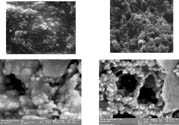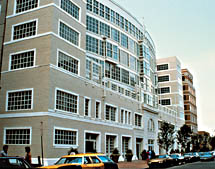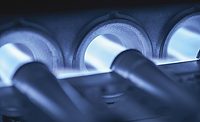(SREP) Silicone Resin Emulsion Paint Applications and References

SREP technology was described in the article, " Silicone Resin Emulsion Paints and Finishes: Durable, Low-VOC Decorative Coating Systems" (PCI January 2001). As such, the intent of this article is to complement the prior article describing the features, advantages and benefits of SREP, and to provide demonstrations including market acceptance and reference objects.

SREP Technology
SREP technology can be described as conventional latex paint technology with silicone resin binder substituted for part of the latex binder. In this respect, the technology is similar to conventional latex coatings. The key difference is that the silicone resin binder allows for formulations using less overall binder (high PVC) due to the well-known ability of silicones to reinforce and bind inorganic (pigments, fillers) and organic (binders) materials. As such, adhesion promoter technology is applied within a paint system (SREP). Other highly recognized properties of silicones including high exterior weathering ability and resistance to biological attack are also imparted to SREP. The key features of SREP formulations are their high water repellency, high vapor permeability, low VOC, waterborne nature, and silicone-resin based structure.


Features, Advantages and Benefits
SREP products exhibit features, advantages and benefits (see Tables 1-2). Features describe what SREP is, and advantages describe what it does. Benefits describe the value to the consumer (coatings manufacturer or end user).For example, the water-repellent feature of SREP provides substrate protection against water damage. This leads to the ability to produce high-performance offerings and to receive the value of those offerings. End users also benefit by saving money that might be spent on repairs. The main cost of re-coating/repair is in the labor and, therefore, protection from water damage provides the consumer with an economical coating. This benefit is also obtained with high-quality conventional latex offerings. Figure 3 shows water repellency results of four examples of SREP having over 8 years of exterior exposure.
A defining characteristic of SREP products is their unique combination of water repellency with high vapor permeability (typically at least 20 perms). This relatively high vapor permeability makes the products resistant to blistering and peeling, allowing coatings to last as long as 25-30 years. As a result, coatings manufacturers find that they can sell the value resulting in good profit margins and quality reputations with green products. Consumers find that they are able to save money over time by not having to re-paint as often. Figure 4 shows vapor permeability test results demonstrating the relatively high vapor permeability of SREP resulting from its porous nature.

Another key feature of SREP is that it can be re-coated. The type of silicone polymers used in developing the silicone emulsion make it possible for the product to be re-coated with standard latex paints or high-performance paints such as SREP. This allows for repeat sales for coatings manufacturers and the flexibility for end users to change the appearance of their substrates. The real demonstration of these benefits comes from the experience European coatings producers and users have with these products.

Market Acceptance
The definitive capability for any coating is its performance under the conditions for which it is intended. In this case, it is SREP's ability to withstand extreme UV exposure in high humidity environments with excellent water repellency and vapor permeability over building structures. Since SREP technology and products were originally developed in Europe, it is not surprising that most applications are found there. In fact, SREP products from a range of coatings manufacturers make up about 20% of the German exterior architectural coatings market and about 10% of the Western European exterior architectural coatings market. This is represented by the fact that every building shown in the picture of the Via San Lorenzo in Geneva where the G7 meetings were held are coated with SREP products (see Figure 5). Buildings protected with SREP can be found from the coldest environmental conditions in Russia (the Kremlin) to southern Italy and Spain. Promotional literature shows that leading European producers including LaFarge Paints, Sigma Coatings, Akzo Nobel, Tikkurila, Sto, Caparol and Boero make SREP products.
Kansas-based PROSOCO recently developed a third-generation of its popular Breathable Masonry Coating (BMC(r)), a SREP for masonry and concrete. PROSOCO's newest edition of its SREP product, BMC(r) 2, has tested at twice the breathability of most latex paints, and up to seven times as breathable as traditional oil-based paint. It also adheres well. In adhesion test ASTM D 4541, the concrete itself pulled apart before the SREP could be pulled off. PROSOCO's choice to pursue the SREP market in the United States was validated in the late 1980s during restoration of the U.S. Capitol. During the restoration, many companies offered to donate their coatings, simply for the promotional value. After testing revealed the advantages of SREP over traditional oil-based and latex paints, conservators chose BMC, and willingly paid full price for every gallon - though they could have had their pick of traditional paints at no cost (see Figures 6-7).

Reference Objects
Water and salt intrusion is detrimental to the integrity of rebar reinforced masonry structures. The combination of salt and water leads to corrosion and expansion of the rebar, cracking, and spalling of the concrete. The New York Department of Transportation recognized the importance of using a breathable, hydrophobic or water repellent coating to decrease the amount of water and salt intrusion and therefore increase the longevity of the structure. It has placed FX 460 Breathable Masonry Coating, Federal Color #27722 on the New York Pre-qualified Materials List. The Windsor Mill Road Bridge is one of several structures painted with this material (see Figure 8). The Westminster House in Baltimore is a 17-story structure that first needed to be repaired from damage caused by salt and water intrusion, and then coated with a SREP system (Fox's FX 460) to add long-term protection (see Figures 9-10).


For more information on silicone resin emulsion paint, contact Wacker Chemical Corp., 3301 Sutton Road, Adrian, MI 49221; phone 800/248.0063; fax 517/264.8620; or visit www. wackersilicones.com.
Links
Looking for a reprint of this article?
From high-res PDFs to custom plaques, order your copy today!




